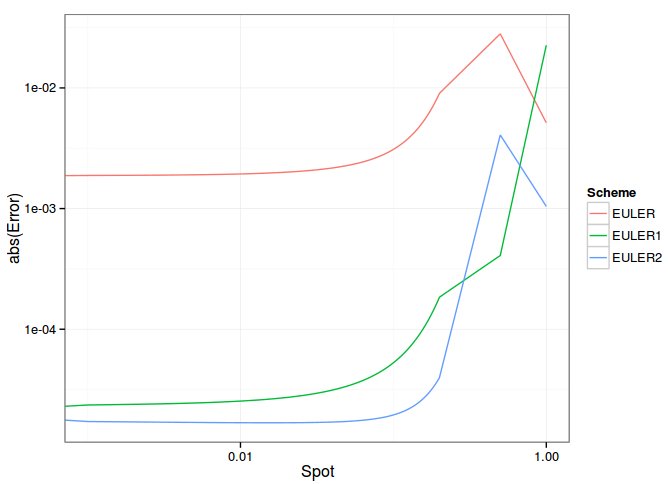Finite Difference Approximation of Derivatives
A while ago, someone asked me to reference him in a paper of mine because I used formulas of a finite difference approximation of a derivative on a non uniform grid. I was shocked as those formula are very widespread (in countless papers, courses and books) and not far off elementary mathematics.
There are however some interesting old papers on the technique. Usually people approximate the first derivative by the central approximation of second order:
$$ f’(x) = \frac{f(x_{i+1})-f(x_{i-1})}{x_{i+1} - x_{i-1}} $$
However there are some other possibilities. For example one can find a formula directly out of the Taylor expansions of \(f(x_{i+1})\) and \(f(x_{i-1})\). This paper and that one seems to indicate it is more precise, especially when the grid does not vary smoothly (a typical example is uniform by parts).
This can make a big difference in practice, here is the example of a Bond priced under the Cox-Ingersoll-Ross model by finite differences. EULER is the classic central approximation, EULER1 uses the more refined approximation based on Taylor expansion, EULER2 uses Taylor expansion approximation as well as a higher order boundary condition. I used the same parameters as in the Tavella-Randall book example and a uniform grid between [0, 0.2] except that I have added 2 points at the far end at 0.5 and 1.0. So the only difference between EULER and EULER1 lies in the computation of derivatives at the 3 last points.

I also computed the backward 2nd order first derivative on a non uniform grid (for the refined boundary). I was surprised not to find this easily on the web, so here it is: $$ f’(x_i) = \left(\frac{1}{h_i}+\frac{1}{h_i+h_{i-1}}\right) f(x_i)- \left(\frac{1}{h_{i-1}}+\frac{1}{h_i}\right) f(x_{i-1})+ \left(\frac{1}{h_{i-1}} - \frac{1}{h_i+h_{i-1}} \right) f(x_{i-2}) + …$$
Incidently while writing this post I found out it was a pain to write Math in HTML (I initially used a picture). MathML seems a bit crazy, I wonder why they couldn’t just use the LaTeX standard.
Update January 3rd 2013 - I now use Mathjax. It’s not very good solution as I think this should typically be handled by the browser directly instead of huge javascript library, but it looks a bit better